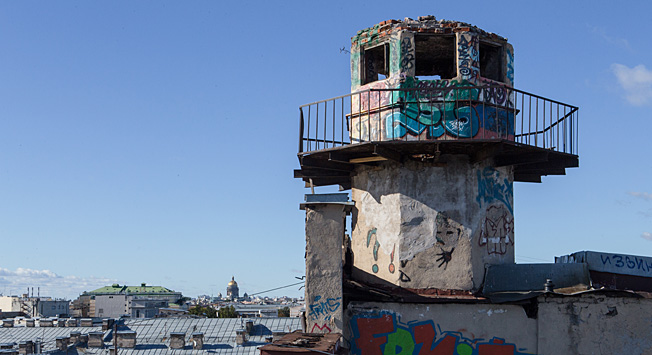St. Petersburg's 7th sky: Who lives on the city's roofs?

RBTH does not condone this activity and this article is in no way is an endorsement of "roofing." It can be very dangerous. Participate at your own risk.
A well-kept yard on ul. Gorokhovaya, a small street in the city center. The “roofer” Sergei, 40 years old, pulls a bunch of keys out of his pocket and on the first try fishes out the correct intercom key and applies it to the lock. The door beeps and we enter a large and aging hallway of a prerevolutionary building. There is no elevator, but the stairs are very low, so it’s not hard to make your way up.
The attic door is sealed. But the seal is only there for appearances. We enter into the darkness of the attic. A mobile phone screen lights low ceiling beams, old pipes and rugs. We climb outside through a tiny window.
“Here we are, on top of the world,” says Sergei triumphantly. “There is a fantastic view of St. Isaac's Cathedral and the Admiralty building. From here you can also see Palace Square and the Alexander Column. Further away are the cranes of the shipyards. The whole city center spreads out before your eyes.”
Photo credit: Grigory Kubatian
Sergei and his friend Konstantin reached an agreement with the tenants of the building, ordered keys and installed planks to create a path so that the tin roof doesn't rumble under the visitors' feet. We walk on the wooden path holding on to the railings, then we climb an iron ladder on our way to the watch tower, which was also renovated by Sergei and Konstantin.
DIY at the top of the world
During the blockade of World War II such towers were used to watch approaching enemy planes. Young boys and girls would come here when incendiary bombs were dropped so that they could determine their locations. Using telephones installed in watchtowers, they would give directions to brigades who were responsible for putting these fires out. About 100 of these towers remain in the city, but almost all of them are in terrible condition with windows smashed in, paint peeling off the walls and broken metal railings and fences.
An old watchtower before development on the roof in St. Petersburg. Photo credit: Grigory Kubatian
Sergei and Konstantin painted the walls of the tower, installed windows and doors, installed the wooden flooring and put a sofa in where it is possible to not only sit comfortably, but also to sleep. They hung curtains and hooked up the space to the electricity grid. They even planted flowers in pots. The result is a small living space featuring four square meters of coziness. People come to drink tea and smoke a hookah pipe.
During the day you can hear bells ringing, and at noon – the cannon shot from Peter and Paul's Fortress. They organize amateur guided tours for young people and photographers, and it is possible to arrange a romantic evening with fruit and champagne. There is even a bio toilet in the attic.
Semi-legal entertainment

Photo credit: Grigory Kubatian
Of course, this is not exactly legal. But the tenants are not against it, and it is hard to understand what particular organization is responsible for the deteriorating watchtowers.
According to Sergei and Konstantin, they contacted the local public housing and utilities unit, the Ministry of Emergency Situations and the city administration at Smolny to try to figure out who is responsible for these towers and if they can legalize their presence on the roof. They wanted to know if they could rent this or some of the other towers and convert them into cafes, micro-hotels or viewing platforms. They received no answer.
The attitude of the authorities to gain access to the roofs is ambiguous. They seem to actively fight the “trespassers” one minute and then plan to open the roofs up to the public the next.
There are legal cafes on roofs and popular rooftop viewing platforms such as the wall of Peter and Paul's Fortress or the Colonnade of St. Isaac's Cathedral. But they are hardly enough to satisfy the seasonal demand of tourists for great views of the city. The peak popularity for the roofs is in summer. During the winters and rainy inter-seasonal periods it's too cold and slippery.
“We try not to be loud and to behave in a civilized manner,” says Sergei. “Once I brought a group of people up for a tour. People were already coming down when suddenly a man came out of his apartment holding a hammer and cursing. He thought we were vandals. I grabbed him by his shoulders and said: ‘What are you doing?! The guests to our city came here to see the beautiful views. And you came and threaten them with a hammer?’ He was ashamed.”
We walk along cast-iron grates that look like those that embellish St. Petersburg's bridges. We come up to the edge and see the brightly lit St. Isaac’s square in the distance. I experience a mixed feeling of delight and unease, as if I am doing something forbidden.
“It's okay,” Sergei says. “Here you can relax. All the fuss is there, on the ground. Up here it's very calm.”
All rights reserved by Rossiyskaya Gazeta.
Subscribe
to our newsletter!
Get the week's best stories straight to your inbox